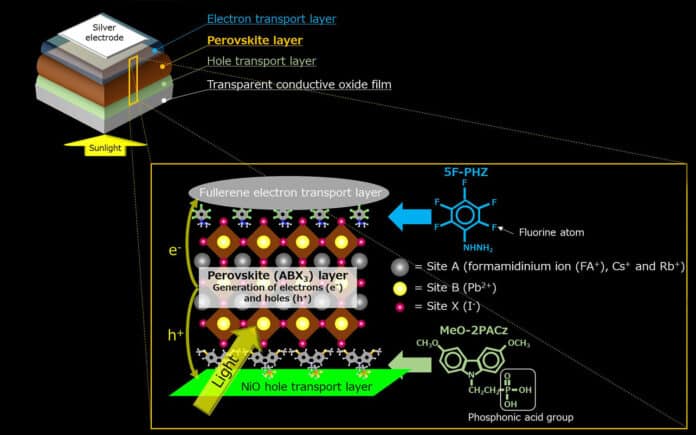Perovskite solar cells (PSCs) are a potentially promising next-generation solar cell technology. They offer several advantages because of their ease of fabrication, low cost, and ability to produce transparent, flexible devices with good quality on a laminated output.
However, perovskite solar cells also have disadvantages. They are prone to degradation when they react with water molecules, and it has proven difficult to make them both durable and highly efficient.
National Institute for Materials Science (NIMS) has developed a durable 1-square-centimeter perovskite solar cell capable of generating electricity for more than 1,000 continuous hours at a photoelectric conversion efficiency (power generation efficiency) of more than 20% in exposure to sunlight. Because this solar cell can be fabricated on the surface of plastic material at approximately 100°C, this technique may be used to develop light, versatile solar cells.
In most perovskite solar cells, when the perovskite layer absorbs sunlight, it generates electrons and holes. These electrons and holes then migrate separately into the adjacent electron transport layer and hole transport layer, respectively, where they flow to produce an electric current. In order to simultaneously improve the efficiency and durability of perovskite solar cells, these layers and the interfaces between them need to enable electrons and holes to move through them more freely while rendering the interfaces impermeable to water molecules.
The NIMS research team added a hydrazine derivative containing water-repellent fluorine atoms (5F-PHZ) to the interface between the electron transport layer and the perovskite layer. The team says this interface successfully prevented water molecules that have penetrated the electron transport layer from coming into contact with the perovskite layer. This results in improving the durability of the solar cell. The use of the interface also reduced the number of crystalline defects that formed on the surface of the perovskite layer – a cause of decreased power generation efficiency.
In addition, the team added a phosphonic acid derivative to the interface between the hole transport layer and the perovskite layer. This minimized defect formation in the hole transport layer and thereby improved the power generation efficiency of the solar cell.
Next, the team plans to develop even more efficient and durable perovskite solar cells by creating a database of molecules that can be integrated into the interface, conducting data-driven research, and designing molecules that can be used to improve interfacial properties.
Journal reference:
- Dhruba B. Khadka, Yasuhiro Shirai, Masatoshi Yanagida, Terumasa Tadano, Kenjiro Miyano. Interfacial embedding for high-efficiency and stable methylammonium-free perovskite solar cells with fluoroarene hydrazine. Advanced Energy Materials, 2022; DOI: 10.1002/aenm.202202029
- Amira R. M. Alghamdi, Masatoshi Yanagida, Yasuhiro Shirai, Gunther G. Andersson, and Kenjiro Miyano. Surface passivation of sputtered NiOx using a SAM interface layer to enhance the performance of perovskite solar cells. ACS Omega 2022; DOI: 10.1021/acsomega.2c00509
